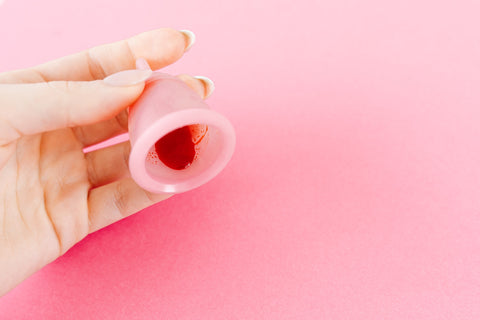You've probably noticed that the color of your menstrual blood varies - from period to period, or even throughout your cycle.
And while there aren't literally 50 different colors in the rainbow of menstrual blood, as such it's likely that your menstrual flow could vary in shade between the grey, pink, bright red and black.
Here's why your period changes color, what each color means and when you should check it up.
WHAT IS PERIOD BLOOD EXACTLY?
Menstrual blood isn't quite like the blood you might see if you cut your finger or scrape your knee. Menstrual blood (or "flow") is a mixture of blood, cervical fluid, and tissue from the uterine lining that spills out once a month and is expelled through the inlet (or outlet? ) of the vagina. It can often vary in consistency depending on where you are in your cycle; it can range from very thin and watery, to thick and a little lumpy (caused by so-called "clots").
WHAT COLOR SHOULD MENSTRUAL BLOOD BE?
Menstrual blood can range from light pink, to bright red, to dark brown and even black - these are generally considered "normal" - but if your menstrual blood is orange, gray, it's a sure sign that it's time to do some checking.
YOUR MENSTRUAL BLOOD CAN CHANGE COLOR DURING THE CYCLE
You will probably notice that the color of your menstrual blood may vary throughout your cycle, even from period to period. Menstrual blood color changes are considered "normal" and usually nothing to worry about (unless your flow is gray, orange or foul - check!).
Your flow may look and feel different at the start of your period than at the end (for example, it may be bright red at the start and more brown towards the end).
There are a few factors that can affect the color of your menstrual flow; such as hormonal changes, your overall health, any underlying health conditions and even how long the flow has been in the womb (i.e. blood that stayed there longer may seem darker).
LET'S TALK ABOUT PERIOD BLOOD COLORS AND WHAT THEY MEAN

Gray - usually a sign of bacterial vaginosis, which is when there is an imbalance in the bacteria in your vagina . Consult a doctor!
Orange - Usually indicates menstrual blood mixed with cervical fluid, but can also indicate that there is a possible infection. Consult a doctor!
Pink - your period may be pink just before it starts or at the end (usually a mixture of menstrual blood and cervical fluid), but they can also be caused by weight loss, unhealthy diet, or an underlying condition such as anemia.
If you're on the birth control pill, that could also explain a pink period, as it lowers estrogen levels. If you have irregular pink spots that aren't related to your period, it could be a sign of cervical cancer, but DON'T STRESS, it could be a number of things. Get checked.
Bright Red - When your period blood is bright red, it usually indicates that it is quite "fresh" (i.e. i.e. it did not stay long in the womb) and also indicates a constant flow.Very rarely, a bright red menstrual flow may indicate signs of cervical cancer, although this is associated with other symptoms, such as heavier periods, smelly vaginal discharge, loss of appetite and weight loss
Dark red or brown – while brown or dark red menstrual blood can be an early sign of pregnancy (what they call "implantation bleeding "), it's also very common at the start or end of your period. It's obviously important to distinguish between the two, so if you're not sure, consult your Doc.
Black – this can indicate the very beginning or the very end of the period, or it can indicate a vaginal blockage; although this is usually accompanied by smelly discharge, itching, or even difficulty peeing. If you don't have these symptoms, it's probably just older blood that hasn't caught on yet.
Purple - Menstrual blood that appears purple may indicate that you have another condition such as polycystic ovary syndrome (PCOS), endometriosis or ovarian cysts. It is usually accompanied by heavy bleeding. See a doctor for a proper diagnosis. Small check-up

DON'T BE AFRAID OF CLOTS
Clots - those big, gel-like drops you sometimes see in your period blood - usually occur when your period is a little heavier (like the first day of your period) and is caused by clotting blood in the womb.
Clots in your period stream are quite common - if they're smaller than the size of a £1 coin and you only get them occasionally, they're probably nothing to worry about. If they are larger (more like the size of a 50 cent coin), occur more frequently, and are accompanied by very heavy periods (for example, you have to change your panties period or your tampon every hour or so), then it's best to get checked, as your clots may be caused by an underlying condition. But of course, if you're not sure, it doesn't hurt to consult a trusted doctor.
Remember: you are more in tune with your own body than anyone else. If you feel like something is wrong or you're not sure about something, see a doctor you trust and get checked out!
.
